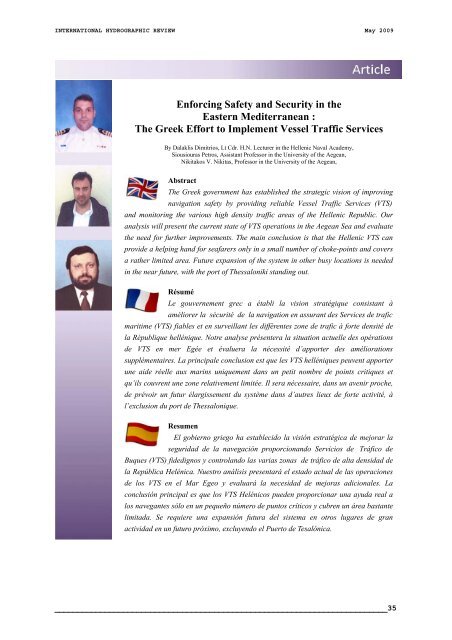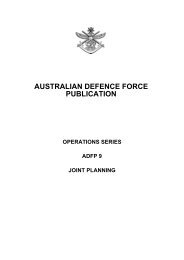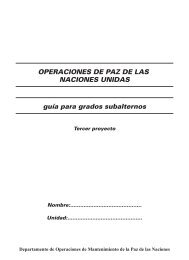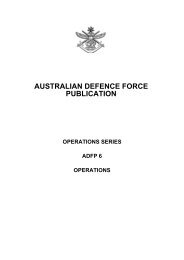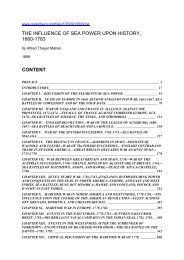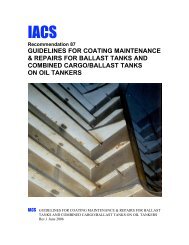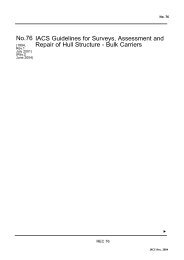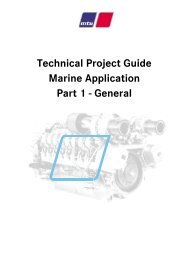The Greek Effort to Implement Vessel Traffic Services
The Greek Effort to Implement Vessel Traffic Services
The Greek Effort to Implement Vessel Traffic Services
Create successful ePaper yourself
Turn your PDF publications into a flip-book with our unique Google optimized e-Paper software.
INTERNATIONAL HYDROGRAPHIC REVIEW May 2009<br />
Enforcing Safety and Security in the<br />
Eastern Mediterranean :<br />
<strong>The</strong> <strong>Greek</strong> <strong>Effort</strong> <strong>to</strong> <strong>Implement</strong> <strong>Vessel</strong> <strong>Traffic</strong> <strong>Services</strong><br />
By Dalaklis Dimitrios, Lt Cdr. H.N. Lecturer in the Hellenic Naval Academy,<br />
Siousiouras Petros, Assistant Professor in the University of the Aegean,<br />
Nikitakos V. Nikitas, Professor in the University of the Aegean,<br />
Abstract<br />
<strong>The</strong> <strong>Greek</strong> government has established the strategic vision of improving<br />
navigation safety by providing reliable <strong>Vessel</strong> <strong>Traffic</strong> <strong>Services</strong> (VTS)<br />
and moni<strong>to</strong>ring the various high density traffic areas of the Hellenic Republic. Our<br />
analysis will present the current state of VTS operations in the Aegean Sea and evaluate<br />
the need for further improvements. <strong>The</strong> main conclusion is that the Hellenic VTS can<br />
provide a helping hand for seafarers only in a small number of choke-points and covers<br />
a rather limited area. Future expansion of the system in other busy locations is needed<br />
in the near future, with the port of <strong>The</strong>ssaloniki standing out.<br />
Résumé<br />
Le gouvernement grec a établi la vision stratégique consistant à<br />
améliorer la sécurité de la navigation en assurant des <strong>Services</strong> de trafic<br />
maritime (VTS) fiables et en surveillant les différentes zone de trafic à forte densité de<br />
la République hellénique. Notre analyse présentera la situation actuelle des opérations<br />
de VTS en mer Egée et évaluera la nécessité d’apporter des améliorations<br />
supplémentaires. La principale conclusion est que les VTS helléniques peuvent apporter<br />
une aide réelle aux marins uniquement dans un petit nombre de points critiques et<br />
qu’ils couvrent une zone relativement limitée. Il sera nécessaire, dans un avenir proche,<br />
de prévoir un futur élargissement du système dans d’autres lieux de forte activité, à<br />
l’exclusion du port de <strong>The</strong>ssalonique.<br />
Resumen<br />
El gobierno griego ha establecido la visión estratégica de mejorar la<br />
seguridad de la navegación proporcionando Servicios de Tráfico de<br />
Buques (VTS) fidedignos y controlando las varias zonas de tráfico de alta densidad de<br />
la República Helénica. Nuestro análisis presentará el estado actual de las operaciones<br />
de los VTS en el Mar Egeo y evaluará la necesidad de mejoras adicionales. La<br />
conclusión principal es que los VTS Helénicos pueden proporcionar una ayuda real a<br />
los navegantes sólo en un pequeño número de pun<strong>to</strong>s críticos y cubren un área bastante<br />
limitada. Se requiere una expansión futura del sistema en otros lugares de gran<br />
actividad en un futuro próximo, excluyendo el Puer<strong>to</strong> de Tesalónica.<br />
_________________________________________________________________________35
INTERNATIONAL HYDROGRAPHIC REVIEW May 2009<br />
Ι. Introduction<br />
Maritime accidents started with the very first<br />
human efforts <strong>to</strong> conquer and tame the seas and<br />
the oceans. For Greece the questions evolving<br />
around maritime accidents are of great<br />
importance given the fact that its commercial<br />
fleet constitutes <strong>to</strong>day the largest maritime fleet<br />
in the world and the <strong>Greek</strong> Navy is becoming<br />
more global in its operations. In the 21 st century,<br />
there is no comparison in the safety level of<br />
vessels when compared even with the very recent<br />
past. For instance, the widespread technological<br />
evolution mankind has experienced, has also<br />
helped naval architects <strong>to</strong> design modern vessels<br />
capable of remaining seaworthy in all sorts of<br />
dire situations -such as extreme weather<br />
conditions- that in the past would surely cause<br />
them <strong>to</strong> founder.<br />
Electronics (and the introduction of the<br />
microprocessor), have made possible a great<br />
number of inventions that have been of great<br />
importance <strong>to</strong> all aspects of human endeavour.<br />
<strong>The</strong> field of navigation is not an exception<br />
(Tetley and Calcutt, 2001). Modern vessels are<br />
equipped with reliable electronic instruments and<br />
devices, while a plethora of electronic systems -<br />
with an enormous range of capabilities- are<br />
available <strong>to</strong> provide their services in all aspects of<br />
the intricate demands of the maritime profession.<br />
A considerable number of electronic means<br />
available nowadays serve the purpose of<br />
determining the position of a vessel at sea in an<br />
easy and precise manner, practically eliminating<br />
the possibility of error. In addition, ship’s bridges<br />
-irrespective of size or mission are full of<br />
au<strong>to</strong>matic devices and systems that greatly reduce<br />
any possibility that a technical error might lead <strong>to</strong><br />
a maritime accident.<br />
Furthermore, the technical infrastructure<br />
accommodating the needs of safe navigation has<br />
also improved on land. It includes, for instance,<br />
radar stations that allow the moni<strong>to</strong>ring/guidance<br />
of ships as well as providing manda<strong>to</strong>ry reporting<br />
and guidance systems for ships and<br />
interconnected databases. <strong>Vessel</strong> traffic services<br />
(VTS) are shorebased systems, which range from<br />
the provision of simple information messages <strong>to</strong><br />
ships, such as position of other traffic or<br />
meteorological hazard warnings, <strong>to</strong> extensive<br />
management of traffic within a port or waterway.<br />
<strong>The</strong> aim of our analysis is <strong>to</strong> briefly present the<br />
process of sea traffic administration by land<br />
stations. Simultaneously, we will focus upon the<br />
current state of <strong>Greek</strong> VTS operations and<br />
evaluate the need for further improvement.<br />
Even though a considerable amount of time has<br />
passed since the first international rules of safe<br />
navigation and collision avoidance at sea were<br />
put in<strong>to</strong> effect, and despite the fact that they have<br />
been constantly amended, revised and<br />
modernized, the dangers present at sea remain<br />
unchanged. Maritime accidents such as<br />
groundings or collisions still frequently make<br />
headline news , despite the fact that the existing<br />
means of avoidance <strong>to</strong>day are present in every<br />
aspect of the maritime profession and far more<br />
reliable than they used <strong>to</strong> be (Pallikaris et all,<br />
2008). Marine accidents have always occurred<br />
and may be expected <strong>to</strong> continue, but those<br />
involved in such activities need <strong>to</strong> exert every<br />
effort <strong>to</strong> ensure safer travel conditions, more<br />
effective operation of vessels and a minimization<br />
of casualties <strong>to</strong> personnel.<br />
II. Maritime Accidents and Environmental<br />
Consequences<br />
Due <strong>to</strong> the international and interconnected<br />
nature of the maritime economy any action taken<br />
<strong>to</strong>wards improvement in all aspects of maritime<br />
activities is far more effective if taken<br />
collectively rather than individually.<br />
Coordination among all parties involved is<br />
needed. Since its inception, in 1959, the<br />
International Maritime Organization 1 (ΙΜΟ) has<br />
exerted every effort <strong>to</strong> protect human life at sea,<br />
adopting practices that have been defined in the<br />
SOLAS convention (Safety of Life at Sea). A<br />
vessel’s technological standing is in reality a key<br />
fac<strong>to</strong>r for the safety of navigation, since modern<br />
vessel design and equipment provide multiple<br />
safety levels; thus more than one fac<strong>to</strong>r have <strong>to</strong><br />
be present for an accident <strong>to</strong> occur. Apart from<br />
SOLAS, IMO has also adopted additional<br />
measures concerning sea safety, either directly or<br />
indirectly. <strong>The</strong>se include the Standards of<br />
1 ΙΜΟ is a intergovernmental organization –under the aegis of the United Nations Organization (UN)- based in London, and is<br />
responsible for the accurate and effective communication/cooperation among its member-states in the field of navigation. <strong>The</strong><br />
Maritime Safety Committee (MSC) of IMO is responsible for safe navigation. Chapter V (shipborne navigational equipment) of the<br />
SOLAS deals with the electronic equipment of vessels. <strong>The</strong> continuous review and improvement the treaty undergoes, covers a wide<br />
range of measures that have been designed especially for the improvement of security of navigation. ΙΜΟ is taking advantage of any<br />
recent technological advancement <strong>to</strong> promote safe navigation, e.g. resolution A. 158 (ES. IV)-Recommendation on Port Advisory<br />
Systems which recognized the need for a VTS system.<br />
36_________________________________________________________________________
INTERNATIONAL HYDROGRAPHIC REVIEW May 2009<br />
Training, Certification and Watchkeeping<br />
(STCW). Conference on the education and<br />
certification of sailors/seamen and the code for<br />
High Speed Ships (HSC Code). <strong>The</strong> International<br />
Safety Management Code (better known as ISM<br />
Code) is one of the most useful <strong>to</strong>ols for the<br />
improvement of the safety of vessels and one of<br />
the pillars of the so called “quality navigation”<br />
(Psaraftis, 2002).<br />
In approaching the term “maritime accident” we<br />
could define it as an incident that occurs at sea and<br />
brings about damage or loss <strong>to</strong> the vessel or cargo<br />
or the environment or human beings and the<br />
shipmaster has an important share of this<br />
responsibility. <strong>The</strong> causes of maritime accidents<br />
are investigated by the flag state, irrespective of<br />
the location where the accident <strong>to</strong>ok place 2 . In<br />
addition <strong>to</strong> the potential for loss of life, pollution,<br />
contamination and degradation are the most<br />
important threats facing the environment as a<br />
result of a maritime accident. As a result of the<br />
pressure exerted by public opinion and the action<br />
taken by environmental organizations, the most<br />
important legislation and regulations were adopted<br />
following important maritime accidents after<br />
concerted action by the IMO.<br />
For instance, after the “Torrey Canyon” accident<br />
in 1967, the International Convention for the<br />
Safety of Life at Sea was enriched (SOLAS 1974)<br />
and the International Convention for the<br />
Prevention of Pollution from Ships (MARPOL<br />
1973/78) were adopted. <strong>The</strong> accident of “Exxon<br />
Valdez” (1989) on the coast of Alaska –in which<br />
36,000 <strong>to</strong>ns of oil were spilt, resulted in the<br />
adoption of the International Convention on Oil<br />
Pollution Preparedness, Response and Cooperation<br />
(OPRC 90) in November 1990, while the US<br />
adopted a pioneering piece of<br />
2 In the case of Greece, there exists a legal provision for the<br />
“administrative examination of the maritime accident” that<br />
is distinguished in a preliminary examination, tactical<br />
examination and the forwarding of the relevant document <strong>to</strong><br />
the Council for the Examination of Maritime Accidents<br />
(CEMA). <strong>The</strong> Coast Guard (CG), a body which<br />
administratively falls under the jurisdiction of the Ministry of<br />
Mercantile Marine, the Aegean and Island Policy (MMM) is<br />
obliged by law <strong>to</strong> examine any incident or accident that occurs<br />
<strong>to</strong> vessels flying the <strong>Greek</strong> flag. In addition, all incidents that<br />
take place within the <strong>Greek</strong> terri<strong>to</strong>rial waters are being dealt<br />
with in exactly the same fashion, irrespective of flag. <strong>The</strong><br />
investigation process may be time consuming, as it entails<br />
sworn attestations by all parties involved in a given accident,<br />
even the potential use of experts for the clarification of<br />
legislation, the Oil Pollution Act (OPA 90) that<br />
prohibits oil tankers without double hull/double<br />
Bot<strong>to</strong>m from entering North American ports and<br />
establishes as legally binding the Unlimited<br />
Responsibility and the economic compensation of<br />
the injured party. <strong>The</strong> loss of ERIKA in 1999 –<br />
causing particularly high level of pollution and<br />
negative publicity- led <strong>to</strong> the adoption of two<br />
important legal initiatives on behalf of the<br />
European Union (EU), namely ERIKA I and<br />
ERIKA II (Psaraftis, 2003). <strong>The</strong> EU is currently<br />
debating further policies in the same direction; the<br />
ERIKA III package of regulations is under<br />
evaluation 3 .<br />
III. <strong>The</strong> International Framework for the<br />
Management of Sea <strong>Traffic</strong><br />
<strong>The</strong> structure of the organizational framework that<br />
governs the use of new technologies in the<br />
provision of modern day navigational services was<br />
developed during the previous decade. In 1997<br />
IMO’s Maritime Safety Committee adopted new<br />
standards for <strong>Vessel</strong> <strong>Traffic</strong> <strong>Services</strong> (VTS) that<br />
are included in chapter 5 of SOLAS for the<br />
establishment of VTS in the area of responsibility<br />
of the IMO member states. At a later date, IMO<br />
and the International Association of Lighthouses<br />
Authorities (IALA) issued recommendations for<br />
the implementation, operation and personnel<br />
training employed by the VTS. Additionally<br />
Regulation 2002/59/EC of August 27, 2002 of the<br />
European Parliament and Council, establishes the<br />
legal basis for a moni<strong>to</strong>ring and information<br />
system for vessel traffic and describes the<br />
framework for the support of navigation by coastal<br />
control stations, aimed at the optimization of sea<br />
transportation. In particular, a framework of<br />
interventionism with navigation is created,<br />
because according <strong>to</strong> the regula<strong>to</strong>rs:<br />
technical issues and the drafting of a report that does not only<br />
simply offer the Ministry’s official view in describing the<br />
actual facts, but also imputes responsibilities <strong>to</strong> the party<br />
responsible for the accident according <strong>to</strong> the aforementioned<br />
process. <strong>The</strong> council in question expresses its opinion on any<br />
disciplinary responsibilities –in case there are no penal ones-<br />
and the case takes its course <strong>to</strong> the Penal Courthouse of the<br />
place of the vessel’s registration or the place where the<br />
company, that is responsible for its management, seats.<br />
3 For extensive details see also:<br />
http://ec.europa.eu/transport/maritime/safety/doc/package3/memo/<br />
2007_03_memo_maritime_safety_en.pdf<br />
_________________________________________________________________________37
INTERNATIONAL HYDROGRAPHIC REVIEW May 2009<br />
Management of the vessels’ traffic and the<br />
adoption of rules for mutual sharing of<br />
information contributes <strong>to</strong> the prevention of<br />
accidents and pollution and <strong>to</strong> the minimization<br />
of the consequences <strong>to</strong>wards the marine and<br />
coastal environment, the economy and the health<br />
of the regional communities.<br />
In order <strong>to</strong> ensure the freedom of navigation, the<br />
<strong>Vessel</strong> <strong>Traffic</strong> <strong>Services</strong> (VTS) is developed, only<br />
in areas of special interest. <strong>The</strong> VTS centre has<br />
the task of communicating directly and<br />
interacting with the vessels that pass through its<br />
area of responsibility, providing solutions <strong>to</strong> any<br />
safety problems that might arise. <strong>The</strong> installation<br />
of VTS centres is normally the responsibility of<br />
the Sea Port Authorities of a given country,<br />
which are charged with the task of overseeing the<br />
implementation of the regulations of maritime<br />
traffic, in a manner parallel <strong>to</strong> that of air traffic<br />
controllers. In detail, these centres are responsible<br />
for the provision of:<br />
• Information <strong>Services</strong>. <strong>The</strong> provision of<br />
information of maritime interest. <strong>The</strong><br />
relevant information provided primarily<br />
relates <strong>to</strong> the positioning of another vessel,<br />
the identity of a certain vessel, a sudden<br />
change in the destination or the planning of<br />
a trip, weather and sea conditions .<br />
Additionally, the centre can interact with a<br />
specific vessel in order <strong>to</strong> clarify any<br />
omissions in the data provided in advance<br />
by the ship’s owner or the ship master.<br />
• Provision of Maritime Assistance <strong>Services</strong>,<br />
the provision of services of importance in<br />
cases of adverse weather conditions,<br />
navigational difficulties, or malfunction of<br />
vessel equipment, under the precondition<br />
that the centre will at all times oversee the<br />
operations so that it can be in a position <strong>to</strong><br />
assist the vessel’s master in making the<br />
correct decision.<br />
• <strong>Traffic</strong> Organization <strong>Services</strong>, the<br />
operational management of traffic, priority<br />
of passage or access <strong>to</strong> ports or zones and<br />
the overall planning for the movement of<br />
vessels, with the aim of reducing traffic<br />
congestion.<br />
<strong>The</strong> effectiveness of any external intervention <strong>to</strong><br />
the management of maritime traffic, and<br />
especially in the management of the access of<br />
vessels <strong>to</strong> ports, depends on the information<br />
provided by the owner of the ship, which has <strong>to</strong><br />
be submitted in sufficient time before the vessel’s<br />
arrival <strong>to</strong> the port. It may be noted that during a<br />
vessel’s transit through a VTS area, the vessel is<br />
obliged <strong>to</strong> abide by the rules and regulations as<br />
well as any special regulations promulgated by<br />
the relevant port authorities, maintain open<br />
frequencies for radio contact and report any<br />
deviation from the agreed course. <strong>The</strong> reporting<br />
of passing vessels has <strong>to</strong> be submitted <strong>to</strong> a VTS<br />
centre, it is distinguished in the initial reporting,<br />
the entry/departure reporting, the final reporting,<br />
the intermediate reporting, the corrective and<br />
finally extraordinary reporting. <strong>The</strong> initial<br />
reporting, for example, is made 15 minutes before<br />
a vessel’s entry <strong>to</strong> a VTS area and not earlier than<br />
30 minutes before entry and it includes besides<br />
information on the vessel’s identity and<br />
destination, information on the type of cargo –<br />
especially when the vessel is carrying hazardous<br />
cargo- and the quality and quantity of fuel or any<br />
oil residues. Information on matters such asthe<br />
type of cargo of the cargoin a vessel that passes<br />
through a coastal area is of particular importance<br />
<strong>to</strong> the coordination and the successful<br />
implementation of a salvage operation or a spill<br />
response.<br />
IV. Analyzing the <strong>Greek</strong> <strong>Effort</strong> in Sea <strong>Traffic</strong><br />
Management<br />
A considerable proportion of the world’s energy<br />
resources –mainly oil and natural gas passes<br />
through the Mediterranean (Dalaklis and<br />
Siousiouras, 2006) and also through the Aegean<br />
Sea. It is from this particular maritime area –<br />
either by oil tankers or through a combination of<br />
pipelines and medium or large tankers- that the<br />
entire trade of energy resources coming from the<br />
Caspian Sea and Russia is being transported. This<br />
trend is expected <strong>to</strong> continue <strong>to</strong> grow after the<br />
completion of the Burgas-Alexandroupoli<br />
pipeline. Greece’s National <strong>Vessel</strong> <strong>Traffic</strong><br />
Management and Information System (VTMIS)<br />
constitutes an integrated system for the electronic<br />
control of sea traffic, built initially <strong>to</strong> provide<br />
VTS <strong>to</strong> a particular area within Greece’s<br />
terri<strong>to</strong>rial waters, with the aim of improving sea<br />
traffic and protection of the marine environment.<br />
<strong>The</strong> Ministry of Mercantile Marine (MMM), in<br />
the context of a modernization policy that is<br />
under way, promotes the development of an<br />
integrated electronic informational system for the<br />
control of maritime traffic, which in it full<br />
38_________________________________________________________________________
INTERNATIONAL HYDROGRAPHIC REVIEW May 2009<br />
Figure 1: Configuration of the <strong>Greek</strong> VTMIS, source: Ministry of Mercantile Marine<br />
implementation, will cover the wider Piraeus sea<br />
region as well as particular areas of the Ionian<br />
Sea, Eastern Aegean and the Cretan Sea.<br />
<strong>The</strong> INTRACOM Company signed an agreement<br />
with the Ministry of Mercantile Marine for the<br />
provision of the VTMIS in 1999, following an<br />
international competition conducted during 1998.<br />
<strong>The</strong> VTS that have already been deployed in the<br />
ports of Piraeus, Patras, Igoumenitsa and Corfu<br />
are linked with the National VTMIS centre which<br />
is located in Piraeus and is capable of controlling<br />
the local centres. <strong>The</strong> system’s objectives are<br />
analyzed below:<br />
• Facilitation of sea traffic, since it is in a<br />
position <strong>to</strong> process all available<br />
information on ports and ships and <strong>to</strong><br />
contribute <strong>to</strong> the organization of the flow<br />
of traffic, the optimum use of docking<br />
facilities, the organization of loading–<br />
unloading process etc.<br />
• Reduction of marine accidents, due <strong>to</strong> the<br />
capability of traffic moni<strong>to</strong>ring provided by<br />
the system and the au<strong>to</strong>mated signaling<br />
warning/alarm system in case of reckless<br />
vessel handling, speed limit violation, entry<br />
<strong>to</strong> forbidden areas etc.<br />
• Improved search and rescue services due <strong>to</strong><br />
the intercommunication with the<br />
Operations Control Area.<br />
• Protection of the marine environment, with<br />
the use of trace-back, since the movement of<br />
vessels is being recorded electronically so<br />
that the capability of retrieving evidence<br />
following the tracing of vessel movement in<br />
case or marine pollution is made possible.<br />
• <strong>Implement</strong>ation of the National and<br />
International Marine legislation.<br />
• Development of the efficiency of sea<br />
transport.<br />
All the information and the overall picture of<br />
navigational movement that are collected and<br />
processed in the local VTS centres are being<br />
transmitted <strong>to</strong> the VTMIS Centre. While the role<br />
of the VTS Centres is mainly operational, the<br />
VTMIS Centre retains a mostly administrative<br />
role. <strong>The</strong> National VTMIS Centre, receives data<br />
from the local VTS centres, proceeds with<br />
processing the piece of information receive and<br />
distributed the output <strong>to</strong> the interested parties. All<br />
standard services provided by the system, such as<br />
the management of sea traffic, the moni<strong>to</strong>ring of<br />
traffic through radars and cameras and the voice<br />
recordings are all synchronized <strong>to</strong> a common date<br />
and time in order <strong>to</strong> provide a unified picture of<br />
all relevant activities. <strong>The</strong> VTMIS centre plays an<br />
executive role and serves as a valuable <strong>to</strong>ol for<br />
the analysis ad traffic data and the overall<br />
strategic planning. At the same time it constitutes<br />
the main interlocu<strong>to</strong>r with other relevant centers<br />
_________________________________________________________________________39
INTERNATIONAL HYDROGRAPHIC REVIEW May 2009<br />
developed in other EU countries or the relevant<br />
national centers responsible for<br />
receiving/forwarding of data.<br />
<strong>The</strong> overall system provides advantages that<br />
elevate the role Greece plays above the regional<br />
scale and contributes <strong>to</strong> the effective protection of<br />
the <strong>Greek</strong> Seas, with change for policy-makers<br />
from suppression <strong>to</strong> prevention. <strong>The</strong> renewed<br />
policy of the MMM achieves the following:<br />
• <strong>The</strong> creation of a system of manda<strong>to</strong>ry<br />
briefing, through which the <strong>Greek</strong><br />
authorities will be in a position <strong>to</strong> access<br />
all relevant information regarding the<br />
movement of vessels that are loaded with<br />
hazardous or pollutant agents and pass<br />
through the <strong>Greek</strong> terri<strong>to</strong>rial waters and<br />
those of the EU member-states and the<br />
exact nature of their cargo.<br />
• <strong>The</strong> exact knowledge of hazardous ship<br />
cargo, of information that has <strong>to</strong> do with<br />
security, as well as that on navigation,<br />
which constitutes the main elements for the<br />
preparation and the effectiveness of<br />
pollution-fighting operations.<br />
• <strong>The</strong> prevention of accidents and marine<br />
pollution and the elimination of the effects<br />
on the marine and coastal environment, the<br />
economy and the health level of the local<br />
communities.<br />
• <strong>The</strong> moni<strong>to</strong>ring of vessels that present<br />
potential risks -due <strong>to</strong> misbehavior or<br />
deteriorated situation- <strong>to</strong> the security of<br />
navigation and the environment.<br />
<strong>The</strong> implementation of the programme will take<br />
place incrementally in two separate stages. <strong>The</strong><br />
first phase of the development of the system has<br />
already been successful and the necessary<br />
establishments are already operational. This<br />
applies <strong>to</strong> the VTS in Piraeus and the VTMIS<br />
Centre in which the following <strong>to</strong>ok place:<br />
• <strong>The</strong> VTS Centre is situated in a room at the<br />
CG HQ Buildings.<br />
• <strong>The</strong> development of (1) a station of sensors<br />
in the NW region of Psitalia island, and the<br />
consequent allocation of another four (4)<br />
sensor stations in the regions of Megali Kira,<br />
Amphiali, Tourlou of Aegina island, Paoura<br />
of Kea island and Fassa of Andros island.<br />
• <strong>The</strong> installation of numerous CCTV cameras<br />
providing full coverage of the Port of Piraeus<br />
(both sea and land areas).<br />
• <strong>The</strong> interconnection of these sensor stations<br />
and the CCTV cameras with the VTS Centre<br />
through the use of digital microwave radio<br />
connections, so that they can be controlled<br />
form a distance without the engagement of in<br />
site permanent personnel.<br />
• Development of two overlapping<br />
departments within the VTMIS Centre (This<br />
approach permits continuous 24 hour<br />
operations).<br />
<strong>The</strong> second phase of the system’s installation has<br />
<strong>to</strong> do with the development of a VTS Centre at<br />
the port of Rafina (currently fully operational)<br />
and a remote terminal station in Lavrio with<br />
sensor stations at the area of the port of Lavrio<br />
and at Vigla of the island of Evia. Installations in<br />
the areas of Patras Bay and the Ionian Sea have<br />
already been completed.<br />
Figure 2: First phase and the stages for expansion of the <strong>Greek</strong> VTS system, source:<br />
Ministry of Mercantile Marine<br />
40_________________________________________________________________________
INTERNATIONAL HYDROGRAPHIC REVIEW May 2009<br />
Figure 3: <strong>The</strong> future expansions of the <strong>Greek</strong> VTS system, source Ministry of Mercantile Marine<br />
Finally, the next phase for the implementation of<br />
the project, that was announced in April 2006<br />
(and was initially scheduled <strong>to</strong> be delivered after<br />
21 months), involves the development of two (2)<br />
VTS for the coverage of the areas of Hania and<br />
Sitia with two respective centres as well as their<br />
incorporation <strong>to</strong> the already existing VTMIS<br />
Centre in Piraeus, which however, presents a<br />
slight delay. <strong>The</strong> infrastructure in Eastern Aegean<br />
is well behind the original schedule and intensive<br />
efforts are needed <strong>to</strong> regain track.<br />
VI. Conclusions<br />
Nearly four fifths of international trade is being<br />
conducted by sea. <strong>The</strong> configuration of the Earth<br />
facilitates sea transport since three quarters of the<br />
planet’s surface is covered by sea or lakes 4 . Due<br />
<strong>to</strong> the availability of commercial vessels massive<br />
transport of goods in a society that is subject <strong>to</strong><br />
increased levels of consumption in goods and raw<br />
material is made technically and financially<br />
possible. Several problems that can be<br />
encountered in short-distance navigation, in<br />
ocean-going navigation and also in passenger<br />
and <strong>to</strong>urist navigation, one must consider the<br />
potential for maritime accidents, sea and coastal<br />
pollution and the congestion of marine<br />
waterways, especially in areas that present the<br />
greatest demand for access.<br />
4 With the exception of the North and South poles, the transport<br />
of passengers and goods by sea-going vessels is possible <strong>to</strong> and<br />
from any part of the world. This fact by itself constitutes a<br />
comparative advantage for sea transport against air or land<br />
transport.<br />
5 Under the auspices of the IMO a whole series of measures have<br />
been introduced, in the form of conventions, recommendations<br />
and other instruments. <strong>The</strong> best known and most important of<br />
Contemporary technology advancements have a<br />
very positive outcome upon improvements <strong>to</strong><br />
navigation safety. Today, a maritime accident<br />
might not involve a human casualty; however it is<br />
always associated with extremely negative results<br />
<strong>to</strong>wards the environment and significant financial<br />
losses. Even in the digital era of the 21 st century,<br />
naval accidents still remain a grave concern both<br />
for military and civilian fleets around the globe.<br />
Numerous mishaps at sea appear quite often in<br />
the news and the negative views of the public<br />
create pressure for action by all parties involved<br />
in the safe conduct of navigation. All available<br />
means <strong>to</strong> prevent a casualty of a vessel should be<br />
used; enforcing appropriate policies <strong>to</strong> regulate<br />
high density traffic deems necessary.<br />
Greece retains one of the leading places in<br />
international merchant navigation, and the<br />
consequent contribution in the <strong>Greek</strong> economy.<br />
For Greece the reciprocal relations between<br />
commercial navigation and national economy,<br />
constitute vessels as the fundamental fac<strong>to</strong>r and<br />
the means of development that are beyond the<br />
boundaries of the transport sec<strong>to</strong>r. Undoubtedly,<br />
transportation by sea constitutes a globalised<br />
industry that is regulated by the IMO conventions<br />
and a legal framework that is subject <strong>to</strong> constant<br />
change and development at the international<br />
level 5 . By placing emphasis on the security of<br />
these measures are conventions, three of which are particularly<br />
relevant <strong>to</strong> navigation. <strong>The</strong>se are the International Convention for<br />
the Safety of Life at Sea, 1974 (SOLAS); the Convention on the<br />
International Regulations for Preventing Collisions at Sea, 1972<br />
(COLREG); and the International Convention on Standards of<br />
Training, Certification and Watch keeping for Seafarers, 1978<br />
(STCW). See also<br />
http://www.imo.org/Safety/mainframe.asp?<strong>to</strong>pic_id=59<br />
_________________________________________________________________________41
INTERNATIONAL HYDROGRAPHIC REVIEW May 2009<br />
navigation and taking advantage of the radical<br />
technological improvements the IMO has actively<br />
promoted the adoption of new technologies in<br />
order <strong>to</strong> avoid marine accidents as well as the<br />
overall support of the tasks shipmasters and<br />
naviga<strong>to</strong>rs have <strong>to</strong> successfully accomplish.<br />
<strong>The</strong> rapid technological developments –in<br />
combination with the acute economic<br />
competition- has created a new reality on the eve<br />
of the 21 st century, according <strong>to</strong> which the<br />
management of information plays a dominant<br />
role, so that sea transport can be implemented<br />
with safety. As the conditions that the modern<br />
mariner has <strong>to</strong> tackle become more multifaceted<br />
and demanding, the provision of any aid is<br />
welcome in order <strong>to</strong> minimize the risk of marine<br />
accidents. VTS overall objectives are <strong>to</strong> enhance<br />
navigational safety and security and promote<br />
marine environment protection. Recognizing the<br />
need <strong>to</strong> make the work load of the bridge officer<br />
easier, resorting <strong>to</strong> technological systems of<br />
increased capabilities seems as the right solution.<br />
Marine accidents have always happened and will<br />
continue <strong>to</strong> do so. <strong>The</strong> crews and all the<br />
competent bodies that regulate the international,<br />
regional or local navigation have <strong>to</strong> exert every<br />
effort in order <strong>to</strong> improve and guarantee better<br />
conditions of travel and more effective vessel<br />
operation having as an ulterior aim <strong>to</strong> safeguard<br />
human life, both those of passengers and those of<br />
seamen.<br />
<strong>The</strong> <strong>Greek</strong> system for the management of sea<br />
traffic undoubtedly presents a series of<br />
advantages for the country, but so far covers only<br />
the wider Piraeus area and the vicinity of Rafina<br />
as well as a small part of the Ionian Sea (the<br />
Igoumenitsa-Corfu Straits, the region of the Bay<br />
of Patras and Rio-Antirio). <strong>The</strong> immediate<br />
completion -without any further delay- of all<br />
relevant installations that were included in the<br />
initial design is deemed necessary. At the same<br />
time, a future expansion is also considered of<br />
critical importance, especially in the cases of the<br />
busy port of <strong>The</strong>ssaloniki, where there are<br />
frequent problems in the traffic of the nearby sea<br />
area, but also in the port of Alexandroupoli,<br />
where the development of the new oil pipeline<br />
creates the need for the docking of oil tankers in<br />
the near future. VTS can contribute significantly<br />
<strong>to</strong> the avoidance of marine accidents, by reducing<br />
the work load of bridge officers and by providing<br />
a completely integrated picture of vessel traffic.<br />
Any assistance that can be provided by land<br />
installations <strong>to</strong> sea traffic –even though it may be<br />
judged by some that it reduces the freedom of<br />
navigation- should be welcomed by all crews, as<br />
it can lead <strong>to</strong> the long-wished-for avoidance of all<br />
unpleasant situations of any kind.<br />
References<br />
Psaraftis Ch. N., (2002), “Maritime Safety: To Be<br />
or Not <strong>to</strong> Be Proactive,” WMU Journal of<br />
Maritime Affairs, Vol. 1-Oc<strong>to</strong>ber, pp. 3-16.<br />
Psaraftis Ch., (2003) “Marine Security: On the<br />
recovery of the lost PRESTIGE”, Nautical<br />
Chronicles, February.<br />
Dalaklis D. and Siousiouras P., (2006),<br />
“Geopolitical Aspirations and Security Strategies<br />
in the Mediterranean: <strong>The</strong> Special Role of the<br />
European Union”, Nafsivios Hora, Hellenic<br />
Naval Academy, p. 261-262.<br />
Siousiouras P. and Dalaklis D., (2007) Safety of<br />
Navigation and Protection of the Marine<br />
Environment: Land Supportive <strong>Services</strong>, p. 1,<br />
presented in the Conference “Environment and<br />
Sea Transport: in pursuit of a Sustainable<br />
Approach – Planning and <strong>Implement</strong>ing<br />
Interventions on Sea Transport and the Protection<br />
of the Marine Environment in the European<br />
Union, and South-East Europe”, Chios Island,<br />
April 19-22, 2007.<br />
Tetley L. and Calcutt D., (2001) Electronic<br />
Navigation Systems, Oxford, Butterworth-<br />
Heinemann, p. ix.<br />
Pallikaris Α. Η., Katsoulis G. and Dalaklis<br />
D.,(2008) Electronic Navigation Equipment,<br />
Athens, Eugenidio Foundation, p. 297.<br />
GMDSS Handbook – (Handbook on the Global<br />
Maritime Distress and Safety System), 3rd<br />
Edition, (2001), London, International Maritime<br />
Organization.<br />
<strong>Greek</strong> Law 712/1970, On administrative control<br />
for marine accidents.<br />
<strong>Greek</strong> Law 1650/1986, On environmental injury.<br />
Webpage<br />
http://www.imo.org/Safety/mainframe.asp?<strong>to</strong>pic_<br />
id=387<br />
Webpage<br />
http://www.imo.org/humanelement/mainframe.as<br />
p?<strong>to</strong>pic_id=287<br />
42_________________________________________________________________________
INTERNATIONAL HYDROGRAPHIC REVIEW May 2009<br />
Webpage<br />
http://ec.europa.eu/transport/maritime/safety/doc/<br />
package3/memo/2007_03_memo_maritime_safet<br />
y_en.pdf<br />
Webpage<br />
http://www.imo.org/Conventions/contents.asp?<strong>to</strong><br />
pic_id=257&doc_id=647#9<br />
Webpage<br />
http://egov.yen.gr/wide/yen.chtm?prnbr=24169<br />
Webpage<br />
http://eurex.europa.eu/LexUriServ/LexUriServ.do?uri=CE<br />
LEX:32002L0059:EL:HTML<br />
Webpage<br />
http://egov.yen.gr/yen.chtm?prnbr=24170<br />
Webpage<br />
http://egov.yen.gr/wide/yen.chtm?prnbr=24172<br />
Biographies of the Authors<br />
Dimitrios Dalaklis graduated from the<br />
Hellenic Naval Academy and followed the<br />
normal carrier path of a Naval Officer, <strong>to</strong><br />
include the command of HS NIKIFOROS. He<br />
holds B.S., a dual M.Sc. from the USA<br />
(Information Technology Management-<br />
Defense Analysis) and is currently a Ph.D.c in<br />
the University of the Aegean (Department of<br />
Shipping, Transport and Trading). He is the<br />
author of numerous articles and scientific<br />
papers published in Greece and abroad; he has<br />
also participated in a significant number of<br />
scientific meetings. From the year 2004, he is<br />
lecturing in the Hellenic Naval Academy<br />
(Department of Combat Systems, Naval<br />
Operations, Sciences of the Sea, Navigation,<br />
Electronics and Communication Systems).<br />
Dimitrios Dalaklis, Lt Cdr. H.N. Lecturer in the<br />
Hellenic Naval Academy,<br />
31 <strong>The</strong>rmopilon St., Salamis, Greece-18900.<br />
Tel: ++302104644136<br />
E-mail:dimitrisdalaklis@hotmail.com<br />
Petros Siousiouras graduated from the Hellenic<br />
Naval Academy and followed the normal carrier<br />
path of a Naval Officer. Holding a Bachelor from<br />
the Panteion University of Political and Social<br />
Sciences and a PhD (with distinction) in<br />
International law from the same University, in the<br />
year 2003 he was elected as a Lecturer in the<br />
University of the Aegean (Department of<br />
Mediterranean Studies-Section of International<br />
Relations and Organizations). He has received<br />
post-graduate studies in Greece (School of<br />
Navigation and Hellenic War College) as well<br />
as in the USA. He is the author of numerous<br />
articles and scientific papers published in<br />
Greece and abroad; he has also participated in a<br />
significant number of scientific meetings.<br />
Today, he is holding the position of Reader in<br />
the University of the Aegean (Department of<br />
Shipping, Transport and Trading).<br />
Petros Siousiouras, Assistant Professor in the<br />
University of the Aegean,<br />
Department of Shipping Trade and Transport,<br />
23 Sokra<strong>to</strong>us St., Kalithea, Greece- 17671<br />
Tel: ++302109524722<br />
E-mail: siou@aegean.gr<br />
Prof. Nikitas Nikitakos has spent 25 years as<br />
Naval Officer (Captain H.N. ret.). He holds B.S.,<br />
M.Sc. in Electrical Engineering from USA and a<br />
Ph.D. in Electrical and Computer Engineering<br />
from National Technical University of Athens<br />
(1996). He is Professor of Shipping, Informatics<br />
and Communications in the University of the<br />
Aegean and Head of the Dept. of Shipping, Trade<br />
and Transport. He is currently AMMITEC’s<br />
(Association of Maritime Managers Information<br />
Technology and Communication) president.<br />
Nikitas Nikita<strong>to</strong>s V., Professor in the University<br />
of the Aegean,<br />
Department of Shipping Trade and Transport,<br />
Korai 2a, Chios, Greece-82100<br />
Tel: +302271035201, fax: +302271035299<br />
E-mail: nnik@aegean.gr<br />
_________________________________________________________________________43


